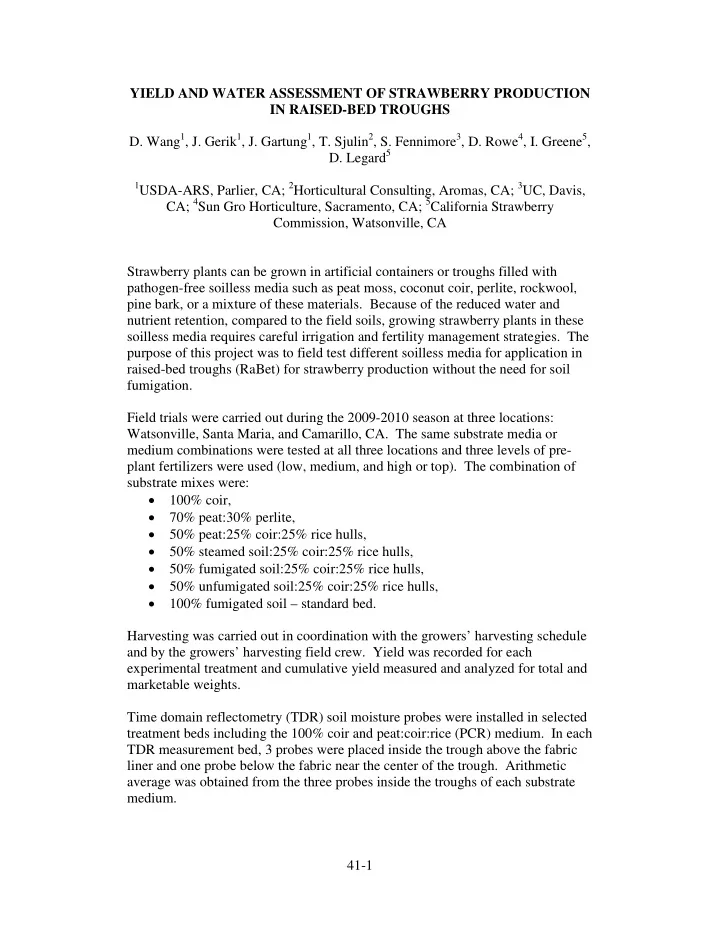

YIELD AND WATER ASSESSMENT OF STRAWBERRY PRODUCTION IN RAISED-BED TROUGHS D. Wang 1 , J. Gerik 1 , J. Gartung 1 , T. Sjulin 2 , S. Fennimore 3 , D. Rowe 4 , I. Greene 5 , D. Legard 5 1 USDA-ARS, Parlier, CA; 2 Horticultural Consulting, Aromas, CA; 3 UC, Davis, CA; 4 Sun Gro Horticulture, Sacramento, CA; 5 California Strawberry Commission, Watsonville, CA Strawberry plants can be grown in artificial containers or troughs filled with pathogen-free soilless media such as peat moss, coconut coir, perlite, rockwool, pine bark, or a mixture of these materials. Because of the reduced water and nutrient retention, compared to the field soils, growing strawberry plants in these soilless media requires careful irrigation and fertility management strategies. The purpose of this project was to field test different soilless media for application in raised-bed troughs (RaBet) for strawberry production without the need for soil fumigation. Field trials were carried out during the 2009-2010 season at three locations: Watsonville, Santa Maria, and Camarillo, CA. The same substrate media or medium combinations were tested at all three locations and three levels of pre- plant fertilizers were used (low, medium, and high or top). The combination of substrate mixes were: • 100% coir, • 70% peat:30% perlite, • 50% peat:25% coir:25% rice hulls, • 50% steamed soil:25% coir:25% rice hulls, • 50% fumigated soil:25% coir:25% rice hulls, • 50% unfumigated soil:25% coir:25% rice hulls, • 100% fumigated soil – standard bed. Harvesting was carried out in coordination with the growers’ harvesting schedule and by the growers’ harvesting field crew. Yield was recorded for each experimental treatment and cumulative yield measured and analyzed for total and marketable weights. Time domain reflectometry (TDR) soil moisture probes were installed in selected treatment beds including the 100% coir and peat:coir:rice (PCR) medium. In each TDR measurement bed, 3 probes were placed inside the trough above the fabric liner and one probe below the fabric near the center of the trough. Arithmetic average was obtained from the three probes inside the troughs of each substrate medium. 41-1
Preliminary data showed that at the Camarillo site, coir and the peat:perlite appeared to have produced relatively higher marketable fruit yields than the other substrate media (Fig. 1). Differences in the harvested yields in the amended soil were consistent in the low and medium levels of pre-plant fertilizers, but no difference in the high or top pre-plant treatment. Overall, there was a slight yield response to pre-plant fertilizer in peat:perlite but no difference or clear trend in other substrate media. Experiments at the Santa Maria and MBA sites are ongoing. Initial results indicated that the marketable fruit yields produced in coir and the peat:perlite media were similar to that found in amended soil received no fumigation or steam treatment. Yields in the amended soil treated with soil fumigation or the peat- coir-rice hull medium were the lowest. Again, there was no clear indication of yield response to the different levels of pre-plant fertilizers. TDR readings changed drastically between irrigation events- increasing immediately after an irrigation event and decreasing quickly after the irrigation (Fig. 2). This is most likely attributed to the low water holding capacity of the substrate media and the much reduced rhizosphere for root water uptake. An unexpected irrigation system malfunction, between May 31 to June 3, caused the TDR readings to drop to very low levels, which likely affected the strawberry growth. Large variations in the TDR recordings also indicated a need for a more robust irrigation system with more frequent irrigations in order to maintain optimal levels of water in the plant root zone. 41-2
Fig. 1. Final cumulative marketable yield of the 2009-2010 season raised-bed trough experiment from the Camarillo field site. 41-3
Fig. 2. TDR soil moisture readings and irrigation in the peat:coir:rice (PCR) and 100% coir plots of the 2009-2010 season raised-bed trough experiment from the Camarillo field site. 5 30 2009-2010 RaBet Camarillo, CA PCR Coir 25 Irrigation 4 20 TDR readings Irrigation (mm) 15 3 10 5 2 0 5/26/10 5/28/10 5/30/10 6/1/10 6/3/10 6/5/10 6/7/10 6/9/10 6/11/10 41-4
Recommend
More recommend